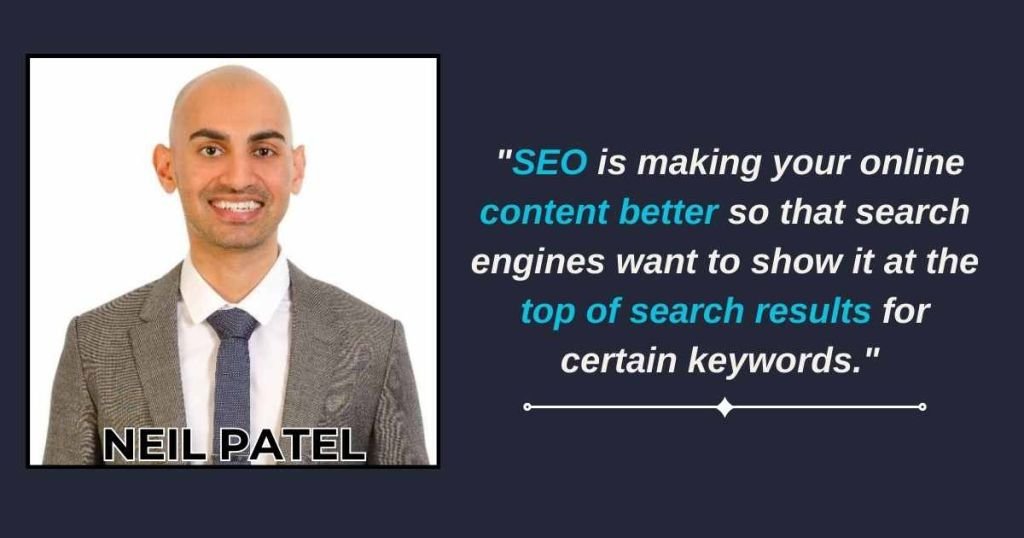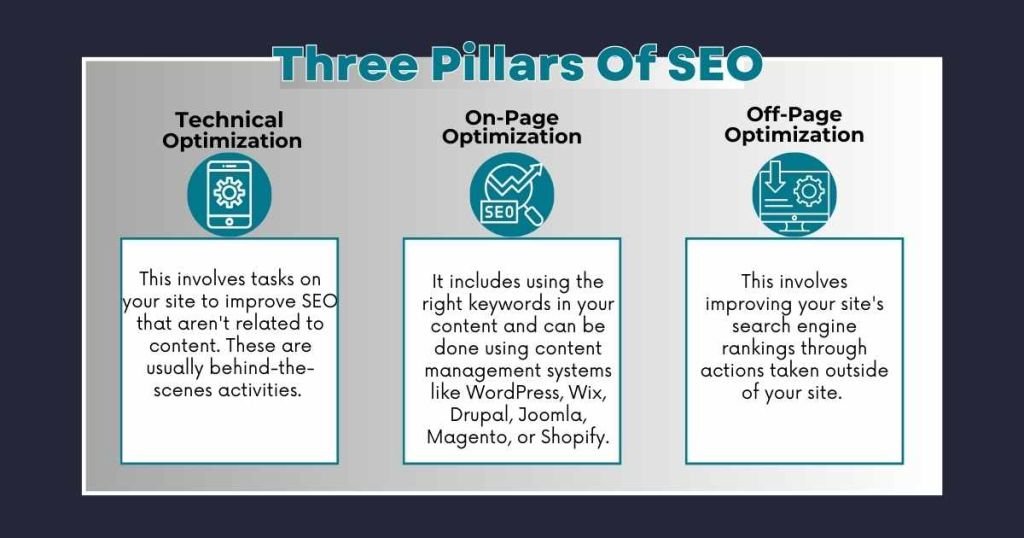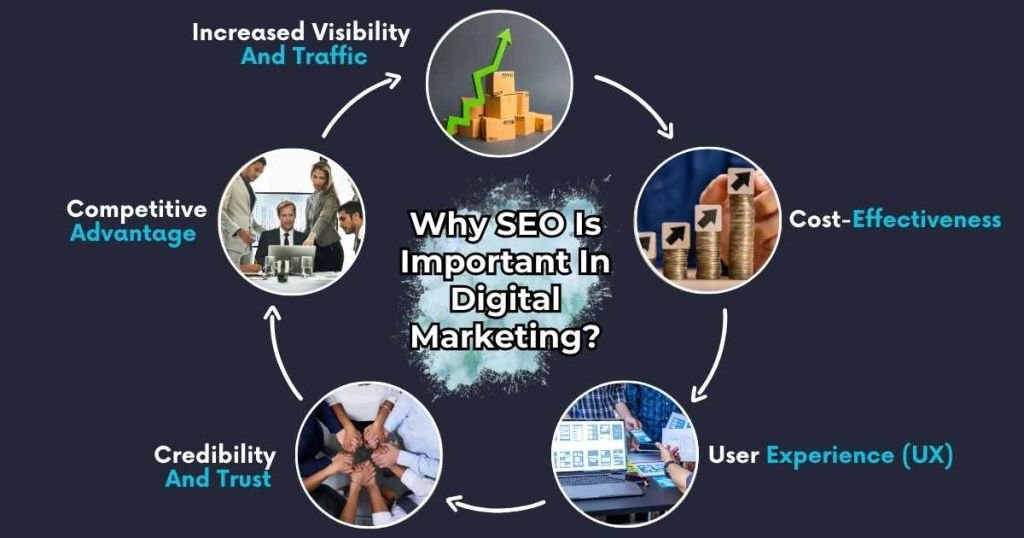Are you running an online business? Do you want to boost your website traffic and sales without spending a lot on ads? Many successful online businesses use SEO (search engine optimization) to improve their Google rankings and get more visibility.
Shopping online is more convenient than ever. Moreover, more people are opting for websites over traditional stores for groceries, clothes, electronics, and more. Additionally, global e-commerce sales are expected to grow significantly, reaching about $6.4 trillion by 2024, marking a 26.7% increase from the previous year.
understanding Search Engine Optimization (SEO)

According to Neil Patel, “SEO is making your online content better so that search engines want to show it at the top of search results for certain keywords.” In simple terms, it means improving your website and its content to make it more appealing to search engines like Google. This helps your site rank higher in search results and brings in more visitors.
SEO, or ‘Search Engine Optimization,’ is the process of getting traffic from free, natural search results on search engines. The goal is to improve your website’s ranking on search results pages (SERPs). As a result, the higher your site appears, the more people will visit it. This increase in visibility can lead to greater brand recognition and increased opportunities for engagement with potential customers.
What Are The Three Pillars Of SEO?

As a digital marketer, knowing how to make your brand, website, or company easily found by searchers is an important skill. Understanding how SEO is evolving will help you stay ahead.
Although SEO changes often in small ways, its main principles stay the same. SEO can be divided into three main parts that you need to know and work on regularly:
1. Technical Optimization
This entails implementing tasks on your website to improve SEO without directly changing content. Additionally, these activities typically happen behind the scenes to enhance technical aspects.
For instance, submitting your sitemap to Google is a straightforward technical optimization that helps search engines understand and index your website more effectively. Other examples include improving site speed, ensuring mobile-friendliness, and optimizing URL structures, all of which contribute to better search engine visibility and user experience.
2. On-Page Optimization
This is about ensuring your site’s content remains relevant and provides an excellent user experience. Additionally, it involves strategically integrating appropriate keywords into your content.
This can be efficiently managed using popular content management systems such as WordPress, Wix, Drupal, Joomla, Magento, or Shopify, which facilitate content updates, keyword optimization, and overall site maintenance to enhance visibility and engagement.
3. Off-Page Optimization
This involves enhancing your site’s search engine rankings by focusing on activities that occur beyond the confines of your website. Furthermore, this is accomplished through the acquisition of high-quality backlinks from reputable sources.
These backlinks not only bolster your site’s credibility but also signal to search engines that your content is valuable and authoritative, thereby contributing significantly to improved visibility and organic traffic.
How Do Search Engines Actually Work?

People use search engines when they have questions and want to find answers online. Search engine algorithms are computer programs that look for clues to give users the exact results they want.
These algorithms help search engines find web pages and decide which ones to show for any keyword. Don’t forget, social media also uses algorithms for search. Search engines work in three steps: crawling, indexing, and ranking.
1. Search Engine Crawling
The first step is crawling. Search engines send out web crawlers to find new pages and record information about them. These web crawlers are sometimes called ‘spiders’, ‘robots’, or ‘Googlebots’.
They discover new web pages and check the content on pages they have already visited to see if they have changed or been updated.
Search engines find web pages by following links they already know about. So, if you have a blog linked from your homepage, when a search engine crawls your homepage, it will follow the link to your new blog post.
2. Search Engine Indexing
The second step in search engine optimization is indexing. Indexing happens when a search engine decides whether or not to use the content it has crawled. If a search engine thinks a web page is good enough, it will add it to its index.
In the final ranking stage, search engines use this index. They store indexed web pages in a database for future retrieval. They typically add web pages with unique and valuable content to the index. However, a web page may not be indexed if:
- The content is a copy of something else
- The content is low quality or spammy
- The page couldn’t be crawled
- The page or site doesn’t have enough inbound links
3. Search Engine Ranking
Ranking, the most important step, occurs only after a search engine has crawled and indexed your site. Once your site undergoes crawling and indexing, the search engine can proceed to rank it.
Search engines use over 200 signals to rank content, which fall under three main areas of SEO: technical optimization, on-page optimization, and off-page optimization.
Here are some examples of signals search engines use to rank web pages:
- Keyword in title tag – If the keyword or a similar word is used on the page and in the title tag
- Loading speed – If the web page loads quickly and is mobile-friendly
- Website reputation – If the web page and website are trusted for the topic being searched for
- Backlinks – The number and quality of other sites linking to a web page
- Content quality and relevance – If the content is useful and relevant to the site’s audience
- Mobile friendliness – If pages, content, and images are optimized for mobile devices
Why SEO Is Important In Digital Marketing

1. Increased Visibility And Traffic
Higher search rankings make your website more visible and bring in more visitors. Moreover, SEO helps attract people looking for your business. Using the right keywords, quality content, and good site performance, you can reach more people and increase conversions. Good SEO also boosts your brand’s credibility.
2. Cost-Effectiveness
Compared to paid advertising, SEO offers a cost-effective strategy. Instead of paying for each click or impression, you invest in optimizing your website to rank higher in search results. Though it requires initial effort, the long-term benefits include sustainable organic traffic without ongoing ad costs.
3. User Experience (UX)
SEO best practices improve site rankings and user experience. However, factors like page speed, mobile responsiveness, and content quality play key roles. A user-friendly, fast-loading site with valuable content encourages visitor engagement and conversions, boosting credibility and trust. This approach not only improves SEO but also builds trust and credibility with your audience.
4. Credibility And Trust
HiHigh search engine rankings increase credibility and trust among users. Moreover, these top positions signify authority and reliability, as users perceive them as trusted sources vetted by search engines like Google.
Being on the first page not only boosts visibility but also enhances perceived expertise and legitimacy, leading to higher engagement and conversions.
5. Competitive Advantage
A strong SEO strategy helps you outshine competitors by ranking higher for key search terms. Furthermore, this boosts visibility, attracts more customers, and enhances credibility, establishing your brand as a trusted leader in your industry for sustained growth.
This competitive advantage not only boosts your online presence but also helps establish your brand as a leader in your industry, driving long-term growth and success.
Final Thoughts
In digital marketing, SEO is essential. Moreover, it’s not just about getting higher rankings on search engines but also about making a website that is easy to use, trustworthy, and performs well for your audience. By combining SEO with other digital marketing strategies, businesses can build a strong and effective online presence that leads to long-term growth and success. Knowing and using SEO is now a must for any business that wants to do well in today’s digital world.
FAQs
What is SEO and why is it important for my website?
SEO, or Search Engine Optimization, enhances your website to boost its visibility in search engine results. Implementing SEO in digital marketing is important because increased visibility can drive more traffic, enhancing brand awareness, customer engagement, and sales. SEO ensures your website is accessible to search engines and optimized to improve its discoverability among your target audience.
How Does SEO Really Work?
SEO improves your website to make it appealing to search engines. Furthermore, they use algorithms to rank sites based on relevance, authority, and user experience. By enhancing your site’s technical setup, content quality, and backlinks, SEO in digital marketing helps search engines understand and value your site for specific searches, resulting in higher rankings.
What is the Main Purpose of SEO?
SEO aims to make websites more visible on search engines, driving increased traffic, engagement, and conversions. However, by enhancing content and technical aspects, SEO boosts relevance and authority for specific searches, improving rankings. This not only attracts more visitors but also builds trust and credibility with users.
How does SEO work?
SEO empowers your website by enhancing technical aspects such as site speed and mobile friendliness, optimizing content with strategic keywords and tags, and cultivating authoritative links. These efforts increase visibility, attract organic traffic, and amplify your online presence without relying on paid advertising.
